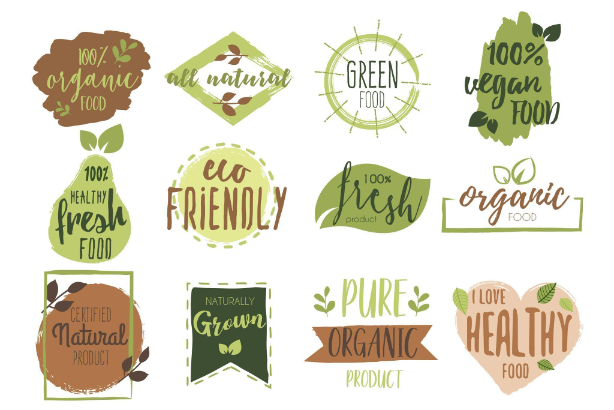By: Bianca Ortalano, Staff Writer

Photo courtesy of FreePik
As time moves forward and people become more aware of the harmful effects of the products they use and consume, food labeling is more important than ever. The health-conscious movement has pushed brands to adapt and has even thrust new companies to the forefront of popularity.[1] Erewhon, a grocery store based out of Los Angeles that has taken the internet by storm, prides itself on being more than a typical grocery store.[2] The store touts that it is a certified organic retailer selling non-GMO, sustainably sourced, local, and regenerative, biodynamic foods.[3] But what do organic, sustainable, and other labeling buzzwords actually mean?
“Organic” labeling may be enticing to some due to their beliefs about its nutritional or health effects, but others may try to avoid it due to its frequently higher pricing.[4] Do customers seeking out organic foods really understand what they are buying? According to the USDA, certified organic foods must be grown and processed within guidelines that regulate soil, farm practices, pest control, and more.[5] For produce, farmers are only allowed to use specific substances in the soil and cannot grow organic produce in soil that has had prohibited substances applied within the last three years.[6] In regards to organic meat, the regulations typically address whether living conditions meet an animal’s typical behavior, which includes prohibiting the administration of antibiotics or hormones.[7] However, for products that contain multiple ingredients, it can be confusing for consumers to understand whether the entire product is organic or only some of the ingredients due to the USDA’s four different organic categories.[8] These categories are: 100 percent organic, organic, “made with” organic ingredients, and specific organic ingredients.[9] The USDA’s distinction between “100 percent organic” and “organic” is due to the fact that manufacturers may label a product as “organic” even if it contains non-organic ingredients, as long as those non-organic ingredients make up five percent or less of the total ingredients.[10] If the amount of non-organic ingredients is greater than five percent but stays below 30 percent, then the product can be classified as “made with organic ingredients.”[11]
In addition to the USDA’s “organic” labels, the FDA has produced regulations surrounding the use of “natural” and “healthy.”[12] As a result of consumer interest, the FDA has created policies to help guide the use of “natural” labels but no formal definition has been created. [13] However, the policy enacted by the FDA states that by labeling a product as “natural” it means that “nothing artificial or synthetic (including all color additives regardless of source) has been included in, or has been added to, a food that would not normally be expected to be in that food.”[14] The FDA clarifies that this term does not apply to food production or manufacturing methods, nor does the term provide any indication of nutritional benefits.[15] The “healthy” food label, on the other hand, does provide insight for consumers regarding the nutrient content of a product.[16] The term “healthy” was first defined by the FDA in 1994 and in 2022 the FDA proposed an updated rule. In order to meet the existing definition, food products must stay within the limits for different nutritional aspects such as total fat or sodium, and contain at least 10% of the Daily Value for one or more vitamins, calcium, iron, and more.[17] The proposed rule would add an additional requirement that food products contain a certain amount of food from at least one of the food groups included in the Dietary Guidelines for Americans recommendation. [18]
Despite the governmental regulations of terms such as “organic”, “natural”, and “healthy” the FDA and USDA do not currently regulate the use of “sustainable” on food labeling.[19] There are companies and organizations that provide their own definition for the term such as the Marine Stewardship Council (“MSC”), which is a global nonprofit.[20] However, the government has yet to adopt a formal set of guidelines that consumers can rely on. Furthermore, although there are policies and guidelines that do regulate the use of certain food labeling, there are still food products that fall through the cracks. Honey, for example, is not regulated by any specific USDA organic labeling guidelines due to the difficulties associated with regulating its production.[21] Honeybees can fly as far as five miles while foraging.[22] The distance of these foraging zones makes it difficult for beekeepers to certify that the plants used for pollen and the soil used to grow them fall within the general organic standards that exist.[23] The current organic standards for livestock have frequently been used to guide the standards for bees, but the National Organic Standards Board has submitted a formal recommendation to the National Organic Program indicating which guidelines should be adopted to specifically allow honey to be a certified organic product.[24] However, the USDA has yet to adopt these recommendations.
Making health-conscious decisions while grocery shopping can be difficult if consumers are unaware of what food labeling terms really mean. However, by digging deeper and utilizing the various definitions and guidelines used to regulate food labeling, ordinary shoppers can take charge and stay informed on the products they are consuming. Individuals seeking to become more educated on food labeling can sign up to receive email updates from the FDA and the USDA.[25] Moreover, the FDA welcomes comments and petitions for or against proposed regulations.[26] Grocery shopping does not need to be confusing or uncertain when it comes to making the right choices for you and your family. Decoding food labels puts the power of choice back in consumers’ hands.
[1] https://www.forbes.com/sites/forbesbusinesscouncil/2024/01/18/five-wellness-trends-for-brands-to-watch-in-2024/?sh=bdfe24c6e7ac
[2] https://www.erewhonmarket.com/about/; https://people.com/what-is-erewhon-all-about-the-los-angeles-grocery-store-chain-loved-by-stars-7566550; https://www.nytimes.com/2021/02/17/style/erewhon-los-angeles-health-food.html; https://www.thecut.com/article/erewhon-smoothie-boston-los-angeles-history.html.
[3] https://www.erewhonmarket.com/about/
[4] https://www.ers.usda.gov/amber-waves/2022/march/consumers-interpretation-of-food-labels-with-production-claims-can-influence-purchases/.
[5] https://www.usda.gov/media/blog/2012/03/22/organic-101-what-usda-organic-label-means.
[6] Id.
[7] Id.
[8] Id.
[9] Id.
[10] Id.
[11] Id.
[12] https://www.fda.gov/food/food-labeling-nutrition/use-term-natural-food-labeling#:~:text=The%20FDA%20has%20considered%20the,to%20be%20in%20that%20food; https://www.fda.gov/food/food-labeling-nutrition/use-term-healthy-food-labeling.
[13] https://www.fda.gov/food/food-labeling-nutrition/use-term-natural-food-labeling#:~:text=The%20FDA%20has%20considered%20the,to%20be%20in%20that%20food.
[14] Id.
[15] Id.
[16] https://www.fda.gov/food/food-labeling-nutrition/use-term-healthy-food-labeling.
[17] Id.
[18] Id.
[19] https://www.huffpost.com/entry/which-food-labels-are-regulated_l_6436b45ae4b06e56d6967843.
[20] https://www.msc.org/en-us/about-the-msc/what-is-the-msc.
[21]https://brookfieldfarmhoney.wordpress.com/2012/01/03/usda-organic-honey-what-does-it-mean/.
[22] https://www.bbka.org.uk/how-far-does-a-bee-fly-how-does-it-navigate.
[23]https://www.ams.usda.gov/sites/default/files/media/NOP%20Livestock%20Final%20Rec%20Apiculture.pdf.
[24] Id.
[25] https://public.govdelivery.com/accounts/USDARD/subscriber/new?qsp=USDARD_59; https://www.fda.gov/about-fda/contact-fda/get-email-updates.
[26] https://www.fda.gov/regulatory-information/dockets-management/comment-proposed-regulations-and-submit-petitions.